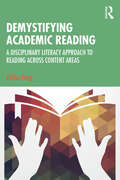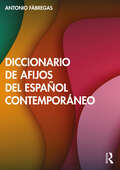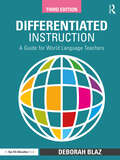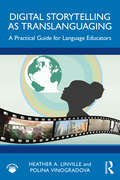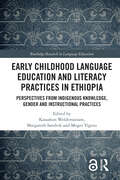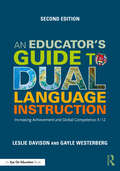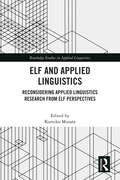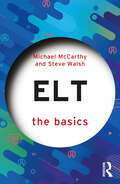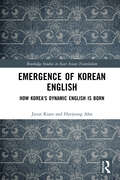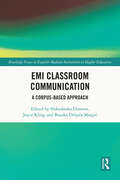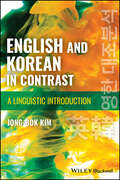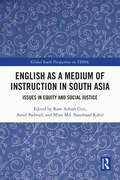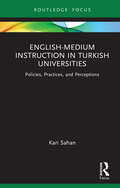- Table View
- List View
Demystifying Academic Reading: A Disciplinary Literacy Approach to Reading Across Content Areas
by Zhihui FangFoundational and accessible, this book equips pre-service and practicing teachers with the knowledge, understanding, tools, and resources they need to help students in grades 4–12 develop reading proficiencies in four core academic subjects—literature, history, science, and mathematics. Applying a disciplinary literacy approach, Fang describes the verbal and visual resources, expert strategies, inquiry skills, and habits of mind that students must learn in order to read carefully, critically, purposefully, and with an informed skepticism across genres and content areas. He also shows how teachers can promote language learning and reading/literacy development at the same time that they engage students in content area learning. With informative synthesis and research-based recommendations in every chapter, this text prepares teachers to help students develop discipline-specific, as well as discipline-relevant, discursive insights, literacy strategies, and ways of thinking, reasoning, and inquiring that are essential to productive learning across academic subjects. It also provides teacher educators with approaches and strategies for helping teacher candidates develop expertise in academic reading instruction. In so doing, the book demystifies academic reading, revealing what it takes for students to read increasingly complex academic texts with confidence and understanding and for teachers to develop expertise that promotes disciplinary literacy. This state-of-the-art text is ideal for courses on reading/literacy methods and academic literacy and eminently relevant to all educators who want their students to become thoughtful readers and powerful learners
Diccionario de afijos del español contemporáneo
by Antonio FábregasEl Diccionario de afijos del español contemporáneo es el primer estudio completo y sistemático de los morfemas que el español utiliza para la formación de palabras. En esta obra se presenta en detalle cada afijo utilizado para construir palabras en español. Este completo diccionario destaca por sus descripciones de las principales propiedades de todos los afijos contemporáneos del español, incluyendo su comportamiento gramatical, clases de bases, significados, comportamiento fonológico y relación con otros afijos. El estudio se complementa con una bibliografía, un glosario de términos y apéndices que clasifican los afijos según diversos criterios. El formato de diccionario, organizado alfabéticamente, permite una consulta rápida y sencilla, y será especialmente útil para investigadores y estudiantes avanzados de morfología española. Diccionario de afijos del español contemporáneo is the first comprehensive and systematic study of the elements that Spanish uses for word formation. Every affix used to build words in Spanish is presented here in detail. This comprehensive dictionary is unique for its descriptions of the main properties of all contemporary Spanish affixes, including their grammatical behavior, base classes, meanings, phonological behavior, and relation to other affixes. The study is complemented by a bibliography, a glossary of terms, and appendices that classify the affixes based on various criteria. The dictionary format, organised alphabetically, allows for quick and easy reference and will be of particular use to researchers and advanced students of Spanish morphology.
Diccionario de afijos del español contemporáneo
by Antonio FábregasEl Diccionario de afijos del español contemporáneo es el primer estudio completo y sistemático de los morfemas que el español utiliza para la formación de palabras. En esta obra se presenta en detalle cada afijo utilizado para construir palabras en español. Este completo diccionario destaca por sus descripciones de las principales propiedades de todos los afijos contemporáneos del español, incluyendo su comportamiento gramatical, clases de bases, significados, comportamiento fonológico y relación con otros afijos. El estudio se complementa con una bibliografía, un glosario de términos y apéndices que clasifican los afijos según diversos criterios. El formato de diccionario, organizado alfabéticamente, permite una consulta rápida y sencilla, y será especialmente útil para investigadores y estudiantes avanzados de morfología española. Diccionario de afijos del español contemporáneo is the first comprehensive and systematic study of the elements that Spanish uses for word formation. Every affix used to build words in Spanish is presented here in detail. This comprehensive dictionary is unique for its descriptions of the main properties of all contemporary Spanish affixes, including their grammatical behavior, base classes, meanings, phonological behavior, and relation to other affixes. The study is complemented by a bibliography, a glossary of terms, and appendices that classify the affixes based on various criteria. The dictionary format, organised alphabetically, allows for quick and easy reference and will be of particular use to researchers and advanced students of Spanish morphology.
Differentiated Instruction: A Guide for World Language Teachers
by Deborah BlazIn the third edition of a bestseller, author Deborah Blaz helps you differentiate lessons for your world language students based on their learning styles, interests, prior knowledge, and comfort zones. This practical book uses brain-based teaching strategies to help students of all ability levels thrive in a rigorous differentiated learning environment. Each chapter provides classroom-tested activities and tiered lesson plans to help you teach vocabulary, speaking, listening, reading, and writing in world language classes in ways that are interactive, engaging, and effective for all learners.Features new to this edition include: activities aligned with the latest ACTFL and CEFR standards ideas and activities for project-based learning, virtual learning, and learning with digital tools, such as ChatGPT up-to-date latest guidance on learning styles and using variety in teaching more photocopiable forms, checklists, and handouts for suggested activities You’ll also learn how to differentiate assessment effectively to help all students show their full potential. Classroom-ready tools and templates can be downloaded as free support material from our website (www.routledge.com/9781032258287) for immediate use.
Differentiated Instruction: A Guide for World Language Teachers
by Deborah BlazIn the third edition of a bestseller, author Deborah Blaz helps you differentiate lessons for your world language students based on their learning styles, interests, prior knowledge, and comfort zones. This practical book uses brain-based teaching strategies to help students of all ability levels thrive in a rigorous differentiated learning environment. Each chapter provides classroom-tested activities and tiered lesson plans to help you teach vocabulary, speaking, listening, reading, and writing in world language classes in ways that are interactive, engaging, and effective for all learners.Features new to this edition include: activities aligned with the latest ACTFL and CEFR standards ideas and activities for project-based learning, virtual learning, and learning with digital tools, such as ChatGPT up-to-date latest guidance on learning styles and using variety in teaching more photocopiable forms, checklists, and handouts for suggested activities You’ll also learn how to differentiate assessment effectively to help all students show their full potential. Classroom-ready tools and templates can be downloaded as free support material from our website (www.routledge.com/9781032258287) for immediate use.
Digital Storytelling as Translanguaging: A Practical Guide for Language Educators
by Heather A. Linville Polina VinogradovaThis innovative, accessible book is an introduction to using digital storytelling in language teaching, with a focus on English as an Additional Language (EAL) instruction. Linville and Vinogradova provide a clear framework that addresses translanguaging and multimodal meaning making in teaching multilingual learners (MLs) through use of digital storytelling.This book provides detailed guidance on how to incorporate digital storytelling into language teaching, building on recent developments in the fields of TESOL and language education that position multilingualism and multiliteracies as important components of any language instruction. Through this text and accompanying activities, readers will understand how to work with MLs to create multimodal digital texts. This book offers an easy-to-follow, step-by-step process for language educators to follow to support MLs’ digital storytelling projects in any EAL classroom. Featured digital storytelling projects from EAL practitioners in various contexts, as well as multiple examples and resources, are included for each stage of the process, always grounded in contemporary TESOL theories (e.g., critical pedagogy, culturally responsive teaching, translanguaging, and a pedagogy of multiliteracies). This framework supports the development of multilingualism and multiliteracies and can be adapted by educators of other world languages for any language education setting.Grounded in contemporary TESOL theories, this book is an essential text for courses on technology in TESOL and TESOL methods courses, as well as for language educators.
Digital Storytelling as Translanguaging: A Practical Guide for Language Educators
by Heather A. Linville Polina VinogradovaThis innovative, accessible book is an introduction to using digital storytelling in language teaching, with a focus on English as an Additional Language (EAL) instruction. Linville and Vinogradova provide a clear framework that addresses translanguaging and multimodal meaning making in teaching multilingual learners (MLs) through use of digital storytelling.This book provides detailed guidance on how to incorporate digital storytelling into language teaching, building on recent developments in the fields of TESOL and language education that position multilingualism and multiliteracies as important components of any language instruction. Through this text and accompanying activities, readers will understand how to work with MLs to create multimodal digital texts. This book offers an easy-to-follow, step-by-step process for language educators to follow to support MLs’ digital storytelling projects in any EAL classroom. Featured digital storytelling projects from EAL practitioners in various contexts, as well as multiple examples and resources, are included for each stage of the process, always grounded in contemporary TESOL theories (e.g., critical pedagogy, culturally responsive teaching, translanguaging, and a pedagogy of multiliteracies). This framework supports the development of multilingualism and multiliteracies and can be adapted by educators of other world languages for any language education setting.Grounded in contemporary TESOL theories, this book is an essential text for courses on technology in TESOL and TESOL methods courses, as well as for language educators.
Early Childhood Language Education and Literacy Practices in Ethiopia: Perspectives from Indigenous Knowledge, Gender and Instructional Practices (Routledge Research in Language Education)
This edited volume explores how indigenous knowledges and practices can be instrumental in improving literacy outcomes and teacher development practices in Ethiopia, aiding children’s long-term reading, and learning outcomes. The chapters present research from a collaborative project between Ethiopia and Norway and demonstrate how students can be supported to think pragmatically, learn critically and be in possession of the citizenship skills necessary to thrive in a multilingual world. The authors celebrate multilingualism and bring indigenous traditions such as oracy, storytelling, folktales to the fore revealing their positive impact on educational attainment. Addressing issues of language diversity and systematic ignorance of indigenous literacy practices, the book plays a necessary role in introducing Ethiopia’s cultural heritage to the West and, hence, bridges the cultural gaps between the global north and global south. Arguably contributing one of the first publications on early literacy in Ethiopian languages, this book will appeal to scholars, researchers and postgraduate students studying the fields of early years literacy and language, indigenous knowledge and applied linguistics more broadly.
Early Childhood Language Education and Literacy Practices in Ethiopia: Perspectives from Indigenous Knowledge, Gender and Instructional Practices (Routledge Research in Language Education)
by Kassahun Weldemariam Margareth Sandvik Moges YigezuThis edited volume explores how indigenous knowledges and practices can be instrumental in improving literacy outcomes and teacher development practices in Ethiopia, aiding children’s long-term reading, and learning outcomes. The chapters present research from a collaborative project between Ethiopia and Norway and demonstrate how students can be supported to think pragmatically, learn critically and be in possession of the citizenship skills necessary to thrive in a multilingual world. The authors celebrate multilingualism and bring indigenous traditions such as oracy, storytelling, folktales to the fore revealing their positive impact on educational attainment. Addressing issues of language diversity and systematic ignorance of indigenous literacy practices, the book plays a necessary role in introducing Ethiopia’s cultural heritage to the West and, hence, bridges the cultural gaps between the global north and global south. Arguably contributing one of the first publications on early literacy in Ethiopian languages, this book will appeal to scholars, researchers and postgraduate students studying the fields of early years literacy and language, indigenous knowledge and applied linguistics more broadly.
An Educator's Guide to Dual Language Instruction: Increasing Achievement and Global Competence, K–12
by Leslie Davison Gayle WesterbergComprehensively updated, the second edition is a user- friendly resource for teachers and administrators to ensure their school’s success in implementing and maintaining a dual language program. The book is filled with step-by-step instructions and strategies you can try immediately. The second edition includes key updates on technology, digital resources, and current demographics, standards, and data. Educators will learn how to choose a model for their dual language program involving all stakeholders in the transition process, set proficiency targets and use assessments to track progress, and much more.
An Educator's Guide to Dual Language Instruction: Increasing Achievement and Global Competence, K–12
by Leslie Davison Gayle WesterbergComprehensively updated, the second edition is a user- friendly resource for teachers and administrators to ensure their school’s success in implementing and maintaining a dual language program. The book is filled with step-by-step instructions and strategies you can try immediately. The second edition includes key updates on technology, digital resources, and current demographics, standards, and data. Educators will learn how to choose a model for their dual language program involving all stakeholders in the transition process, set proficiency targets and use assessments to track progress, and much more.
ELF and Applied Linguistics: Reconsidering Applied Linguistics Research from ELF Perspectives (Routledge Studies in Applied Linguistics)
by Kumiko MurataWith help from a global cast of scholars, Kumiko Murata explores the remodelling of the discipline of applied linguistics, which traditionally regarded Anglophone native-speaker English as the standard for English as a lingua franca (ELF).This edited volume probes the dichotomy between the current focus of applied linguistic research and a drastically changed English use in a globalised world. This division is approached from diverse perspectives and with the overarching understanding of ELF as an indispensable area of applied linguistics research. The volume includes theoretical backgrounds to English as a lingua franca, the nature of ELF interactions, language policy and practice from an ELF perspective, and the relationship between multilingualism and ELF.A resourceful book not only to ELF researchers but also applied linguists in general, as well as policy makers, administrators, practicing teachers, and university students from diverse linguacultural backgrounds.
ELF and Applied Linguistics: Reconsidering Applied Linguistics Research from ELF Perspectives (Routledge Studies in Applied Linguistics)
by Kumiko MurataWith help from a global cast of scholars, Kumiko Murata explores the remodelling of the discipline of applied linguistics, which traditionally regarded Anglophone native-speaker English as the standard for English as a lingua franca (ELF).This edited volume probes the dichotomy between the current focus of applied linguistic research and a drastically changed English use in a globalised world. This division is approached from diverse perspectives and with the overarching understanding of ELF as an indispensable area of applied linguistics research. The volume includes theoretical backgrounds to English as a lingua franca, the nature of ELF interactions, language policy and practice from an ELF perspective, and the relationship between multilingualism and ELF.A resourceful book not only to ELF researchers but also applied linguists in general, as well as policy makers, administrators, practicing teachers, and university students from diverse linguacultural backgrounds.
ELT: The Basics (The Basics)
by Michael McCarthy Steve WalshELT: The Basics offers a clear, non-jargonistic introduction to English language teaching for EFL/ESL teachers in training, early career teachers, those considering taking up ELT, and experienced teachers who may want to read about the way the profession has developed and continues to evolve. Key features of this book include: Real classroom data and data from ELT training programmes Discussion of a wide range of learning contexts and different types of learners (young learners, adults, third age, academic, refugees and immigrants, etc.) Comparisons of different types of syllabuses and methods, and discussion of current technologies An emphasis on classroom interaction as the key to maximising learning Featuring a glossary of key terms, cartoons and illustrations, further reading, personal reflection points, and discussion of the most important and relevant research, this book is a clear and accessible introduction to the complex field of ELT.
ELT: The Basics (The Basics)
by Michael McCarthy Steve WalshELT: The Basics offers a clear, non-jargonistic introduction to English language teaching for EFL/ESL teachers in training, early career teachers, those considering taking up ELT, and experienced teachers who may want to read about the way the profession has developed and continues to evolve. Key features of this book include: Real classroom data and data from ELT training programmes Discussion of a wide range of learning contexts and different types of learners (young learners, adults, third age, academic, refugees and immigrants, etc.) Comparisons of different types of syllabuses and methods, and discussion of current technologies An emphasis on classroom interaction as the key to maximising learning Featuring a glossary of key terms, cartoons and illustrations, further reading, personal reflection points, and discussion of the most important and relevant research, this book is a clear and accessible introduction to the complex field of ELT.
Emergence of Korean English: How Korea's Dynamic English is Born (Routledge Studies in East Asian Translation)
by Jieun Kiaer Hyejeong AhnEmergence of Korean English explores the dynamic nature of emerging Korean English and its impact on Korean society, culture, and identity. This book challenges the negative stereotypes and stigmatization of Konglish and argues that it has been a great asset for Korea’s fast economic development. The fate of Korean English has been transformed in the time of the Korean wave as the K-fandom actively engages with Korean English. The book offers a comprehensive overview of Korea’s encounter with the English language and provides an in-depth analysis of linguistic characteristics, pragmatic features, and cross-cultural and cross-linguistic aspects of Korean English. The authors examine the unique linguistic features of Korean English, including phonological, syntactic, and lexical features, and highlight the sociocultural implications of these features for Korean society. In addition, the book discusses the role of Hallyu fandom languages in the emergence of Korean English and the growth of Korean pop culture worldwide. It also provides insights into the English fever in South Korea and its impact on education, society, and culture. This book is a valuable resource for scholars, students, and professionals who are interested in the emergence of Korean English and its social, cultural, and linguistic implications for Korea and the global community.
Emergence of Korean English: How Korea's Dynamic English is Born (Routledge Studies in East Asian Translation)
by Jieun Kiaer Hyejeong AhnEmergence of Korean English explores the dynamic nature of emerging Korean English and its impact on Korean society, culture, and identity. This book challenges the negative stereotypes and stigmatization of Konglish and argues that it has been a great asset for Korea’s fast economic development. The fate of Korean English has been transformed in the time of the Korean wave as the K-fandom actively engages with Korean English. The book offers a comprehensive overview of Korea’s encounter with the English language and provides an in-depth analysis of linguistic characteristics, pragmatic features, and cross-cultural and cross-linguistic aspects of Korean English. The authors examine the unique linguistic features of Korean English, including phonological, syntactic, and lexical features, and highlight the sociocultural implications of these features for Korean society. In addition, the book discusses the role of Hallyu fandom languages in the emergence of Korean English and the growth of Korean pop culture worldwide. It also provides insights into the English fever in South Korea and its impact on education, society, and culture. This book is a valuable resource for scholars, students, and professionals who are interested in the emergence of Korean English and its social, cultural, and linguistic implications for Korea and the global community.
EMI Classroom Communication: A Corpus-Based Approach (Routledge Focus on English-Medium Instruction in Higher Education)
by Slobodanka Dimova Joyce Kling Branka Drlja 269 A Margi 263Examining English medium instruction (EMI) through a corpus-based approach, this volume offers a critical inquiry into the use of different linguistic and pedagogical strategies in the EMI classroom. It explores aspects of content lecturers’ language use, pedagogy, and intercultural communicative competence by drawing on the findings obtained from EMI lecture corpus analysis and post-observation interviews with EMI lecturers from five universities in Croatia, Denmark, Italy, the Netherlands, and Spain. The book also offers insights into lecturers’ engagement with students in English, which is their second language, as well as their perception of differences between EMI and first-language-medium instruction (L1MI). Finally, the volume provides readers with corpus-based analysis of teachers’ oral ability profiles, as a basis for the identification of communicational challenges and provision of language support. The book will be of interest to scholars interested in EMI in higher education, and postgraduate students in applied linguistics and TESOL programs. It will also be relevant to teachers who are involved in EMI provision, teacher trainers who design support programs for EMI teachers, and policymakers who establish language-in-education policies for EMI.
EMI Classroom Communication: A Corpus-Based Approach (Routledge Focus on English-Medium Instruction in Higher Education)
by Slobodanka Dimova Joyce Kling Branka Drljača MargićExamining English medium instruction (EMI) through a corpus-based approach, this volume offers a critical inquiry into the use of different linguistic and pedagogical strategies in the EMI classroom. It explores aspects of content lecturers’ language use, pedagogy, and intercultural communicative competence by drawing on the findings obtained from EMI lecture corpus analysis and post-observation interviews with EMI lecturers from five universities in Croatia, Denmark, Italy, the Netherlands, and Spain. The book also offers insights into lecturers’ engagement with students in English, which is their second language, as well as their perception of differences between EMI and first-language-medium instruction (L1MI). Finally, the volume provides readers with corpus-based analysis of teachers’ oral ability profiles, as a basis for the identification of communicational challenges and provision of language support. The book will be of interest to scholars interested in EMI in higher education, and postgraduate students in applied linguistics and TESOL programs. It will also be relevant to teachers who are involved in EMI provision, teacher trainers who design support programs for EMI teachers, and policymakers who establish language-in-education policies for EMI.
English and Korean in Contrast: A Linguistic Introduction
by Jong-Bok KimENGLISH AND KOREAN IN CONTRAST English and Korean in Contrast: A Linguistic Introduction is the first book of its kind to present a comprehensive yet student-friendly comparative review of the grammars of English and Korean. Author Jong-Bok Kim, an internationally-recognized expert, offers rigorous contrastive analyses of all major aspects of English and Korean while addressing common usage errors made by learners of each language. Designed for both English- and Korean-language classrooms, this unique textbook describes and contrasts the two languages at every level from sound, word, and grammar to figurative language and metaphors. Throughout the text, the author uses an accessible, descriptive-based approach that covers both core and peripheral phenomena of English and Korean. Offering invaluable insights into the major sources of difficulty or ease in learning the two languages, English and Korean in Contrast: A Linguistic Introduction is the perfect undergraduate resource not only for English-speaking students studying Korean language and linguistics, but also for Korean-speaking students studying English language and linguistics.
English and Korean in Contrast: A Linguistic Introduction
by Jong-Bok KimENGLISH AND KOREAN IN CONTRAST English and Korean in Contrast: A Linguistic Introduction is the first book of its kind to present a comprehensive yet student-friendly comparative review of the grammars of English and Korean. Author Jong-Bok Kim, an internationally-recognized expert, offers rigorous contrastive analyses of all major aspects of English and Korean while addressing common usage errors made by learners of each language. Designed for both English- and Korean-language classrooms, this unique textbook describes and contrasts the two languages at every level from sound, word, and grammar to figurative language and metaphors. Throughout the text, the author uses an accessible, descriptive-based approach that covers both core and peripheral phenomena of English and Korean. Offering invaluable insights into the major sources of difficulty or ease in learning the two languages, English and Korean in Contrast: A Linguistic Introduction is the perfect undergraduate resource not only for English-speaking students studying Korean language and linguistics, but also for Korean-speaking students studying English language and linguistics.
English as a Medium of Instruction in South Asia: Issues in Equity and Social Justice (Global South Perspectives on TESOL)
by Ram Ashish Giri Amol Padwad Kabir, Mian Md. NaushaadThis book examines the ‘English mania phenomenon’ and the complex circumstances of adopting English Medium Instruction (EMI) by South Asian education systems and the effect of an uneven distribution of resources on the already under-resourced countries in the region. Chapters explore linguistic, social, and economic injustices by using an analytic-critical approach to examinations of the place, role, provisions, and practices of EMI in specific English language teaching (ELT) contexts. The book consequently advocates for the wholescale reform of a system, which, the authors argue, is unjust. Ultimately, the book explores socio-cultural, poststructuralist, and English linguistic imperialism theories to contribute a South Asian perspective on the controversy surrounding EMI and examine its role within a wider global discourse on equity and social justice. Critically examining the spread of English in South Asia, this book will be of relevance to researchers, scholars, and postgraduate students in applied linguistics, language education, TESOL, and sociolinguistics.
English as a Medium of Instruction in South Asia: Issues in Equity and Social Justice (Global South Perspectives on TESOL)
This book examines the ‘English mania phenomenon’ and the complex circumstances of adopting English Medium Instruction (EMI) by South Asian education systems and the effect of an uneven distribution of resources on the already under-resourced countries in the region. Chapters explore linguistic, social, and economic injustices by using an analytic-critical approach to examinations of the place, role, provisions, and practices of EMI in specific English language teaching (ELT) contexts. The book consequently advocates for the wholescale reform of a system, which, the authors argue, is unjust. Ultimately, the book explores socio-cultural, poststructuralist, and English linguistic imperialism theories to contribute a South Asian perspective on the controversy surrounding EMI and examine its role within a wider global discourse on equity and social justice. Critically examining the spread of English in South Asia, this book will be of relevance to researchers, scholars, and postgraduate students in applied linguistics, language education, TESOL, and sociolinguistics.
English-Medium Instruction in Turkish Universities: Policies, Practices, and Perceptions (Routledge Focus on English-Medium Instruction in Higher Education)
by Kari SahanIn response to the growing use of English as an international language, the number of English-medium instruction (EMI) programs in higher education has increased. However, decisions to implement EMI programs are often made through top-down policymaking processes with little consideration for the educational issues surrounding language policy changes.This book examines the variation with which EMI is implemented at universities in Turkey through a multilevel empirical investigation of policies, practices, and perceptions. In addition to providing a sociohistorical overview of EMI in Turkey, the book draws on a dataset that includes policy documents, classroom observations, interviews with teachers, and focus group discussions with students. Despite national policies which envision a "one-language-at-a-time" model of EMI education, this book argues that EMI is neither English-only nor English-always in practice. By highlighting the variation with which EMI is implemented at and across Turkish universities, this study illustrates the need for more comprehensive EMI policies and processes aimed at integrating content and language learning in higher education.Implications are discussed with respect to policy planning, program development, and pedagogical support and will be relevant for researchers and postgraduate research students interested in EMI, particularly in the Turkish context.
English-Medium Instruction in Turkish Universities: Policies, Practices, and Perceptions (Routledge Focus on English-Medium Instruction in Higher Education)
by Kari SahanIn response to the growing use of English as an international language, the number of English-medium instruction (EMI) programs in higher education has increased. However, decisions to implement EMI programs are often made through top-down policymaking processes with little consideration for the educational issues surrounding language policy changes.This book examines the variation with which EMI is implemented at universities in Turkey through a multilevel empirical investigation of policies, practices, and perceptions. In addition to providing a sociohistorical overview of EMI in Turkey, the book draws on a dataset that includes policy documents, classroom observations, interviews with teachers, and focus group discussions with students. Despite national policies which envision a "one-language-at-a-time" model of EMI education, this book argues that EMI is neither English-only nor English-always in practice. By highlighting the variation with which EMI is implemented at and across Turkish universities, this study illustrates the need for more comprehensive EMI policies and processes aimed at integrating content and language learning in higher education.Implications are discussed with respect to policy planning, program development, and pedagogical support and will be relevant for researchers and postgraduate research students interested in EMI, particularly in the Turkish context.
